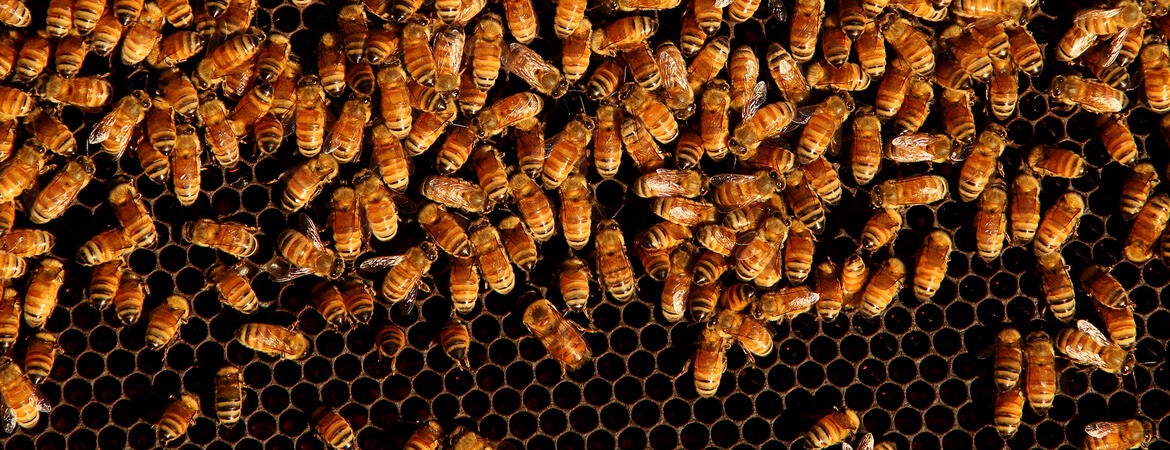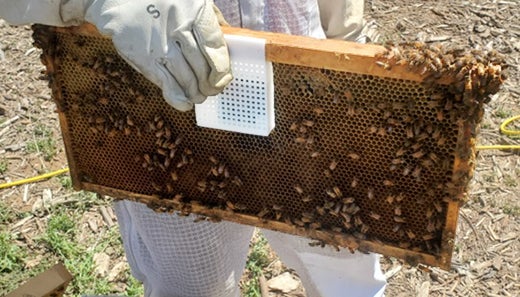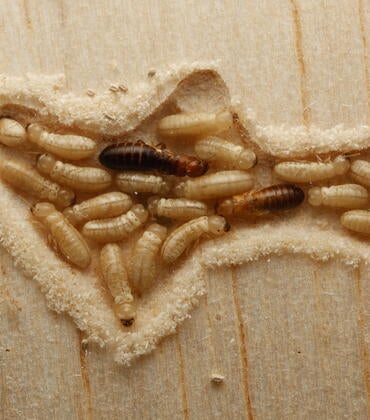
A UC Riverside computer science team has developed a sensor-based technology that could revolutionize commercial beekeeping by reducing colony losses and lowering labor costs.
Called the Electronic Bee-Veterinarian, or EBV, the technology uses low-cost heat sensors and forecasting models to predict when hive temperatures may reach dangerous levels. The system provides remote beekeepers with early warnings, allowing them to take preventive action before their colonies collapse during extreme hot or cold weather or when the bees cannot regulate their hive temperature because of disease, pesticide exposure, food shortages, or other stressors.
“We convert the temperature to a factor that we are calling the health factor, which gives an estimate of how strong the bees are on a scale from zero to one,” said Shamima Hossain, a Ph.D. student in computer science at UCR and lead author of a paper explaining the technology.
This simplified metric — with a score of ‘one' meaning the bees are at full strength — allows beekeepers unfamiliar with the underlying model to assess hive health quickly.
Boris Baer, a UCR professor of entomology, believes the technology could revolutionize beekeeping, which is essential to vast sectors of global agriculture. Honeybees pollinate more than 80 crops and contribute an estimated $29 billion annually to U.S. agriculture. Yet bee populations have declined due to various factors, including habitat loss, pesticide exposure, parasites, and climate change.
“Over the last year, the U.S. lost over 55% of its honeybee colonies,” Baer said, citing data from Project Apis m., which monitors beehive losses throughout the U.S. “We are experiencing a major collapse of bee populations, and that is extremely worrying because about one-third of what we eat depends on bees.”
Beekeepers now rely on their own judgment and manual inspections to detect problems, often leading to delayed interventions. With EBV, they can get real-time insights and predict conditions days in advance, significantly reducing labor costs, said Baer, who collaborated with Hossain and other scientists at UCR’s Bourns College of Engineering.
“People have dreamed of these sensors for a very long time,” Baer said. “What I like here is that this system is fully integrated into the hive setup that beekeepers already use.”
Temperature fluctuations are among the first responses to any kind of threats to a hive’s health. Honeybees maintain a precise internal hive temperature between 33 and 36 degrees Celsius (91.4–96.8°F), a requirement for proper brood development and colony survival, Baer said.
The EBV method is based on thermal diffusion equations and control theory, making its predictions interpretable to both scientists and beekeepers, Hossain said. The model uses temperature data collected from low-cost sensors installed inside the hive, feeding that information into an algorithm that predicts hive conditions several days in advance.
In tests conducted at UCR’s apiary, the EBV method analyzed data from 10 hives during initial development and later expanded to 25 hives. The technology has already proven its effectiveness, detecting conditions that required beekeeper intervention.
“When I looked at the dashboard and saw the health factor dropped below an empirical threshold, I contacted our apiary manager,” Hossain recalled. “When we went to check the hive, we found that there was actually something wrong, and they were able to take action to manage the situation.”
Hyoseung Kim, an associate professor of electrical and computer engineering at UCR, explained that keeping costs low — under $50 per hive — is a high priority.
“There are commercial sensors available, but they are too expensive,” Kim said. “We decided to create a very cheap device using off-the-shelf components so that beekeepers can afford it.”
The research team is already working on the next phase, which is to develop automated hive climate controls that can be installed on hives and respond to EBV’s predictions, adjusting hive temperatures automatically.
“Right now, we can only issue warnings,” Hossain said. “But in the next phase, we are working on designing a system that can automatically heat or cool the hive when needed.”
The title of Hossain’s paper is “Principled Mining, Forecasting and Monitoring of Honeybee Time Series with EBV+” In addition to Hossain, Baer and Kim, the co-authors are Christos Faloutsos, professor of computer science at Carnegie Mellon University, and Vassilis Tsotras, professor of computer science and engineering at UCR.
All the authors are with UCR’s Center for Integrative Bee Research, one of the largest pollinator health research hubs in the nation.
The interdisciplinary collaboration was made possible through the UCR Data Science Center and the RAISE@UCR AI Institute. The research also has been supported by the U.S. Department of Agriculture's National Institute of Food and Agriculture grants No. 2024-67022-43695 and No. 2024-67021-43696; UC Multicampus Research Programs and Initiatives award # M21PR2306; a UCR's SoCal OASIS™ funding award; and the UCR Delfino Agriculture Innovation Seed Fund.
Header photo: Bees a honeycomb cell in Sydney, Australia. (Photo by Lisa Maree Williams/Getty Images)





